
11 minute read
SYSTEMS ENGINEERING RESOURCES
SYSTEMS ENGINEERING RESOURCESSYSTEMS ENGINEERING RESOURCES
Useful artifacts to improve your SE effectiveness Useful artifacts to improve your SE effectiveness
Advertisement
SysML Extension for Physical Interaction and Signal Flow Simulation
The Object Management Group (OMG) released, in May, 2021, an updated standard called SysML Extension for Physical Interaction and Signal Flow Simulation (SysPhS). The update specifies standards for translations between: • Overall systems engineering modeling, done with Systems Modeling Language (SysML) • Simulations of physical interactions and signal flows within the system being engineered Prior to this update, system engineers used SysML and other modeling languages to create a model of an intended system. Systems engineers then described to other-domain engineers (electrical, mechanical, production, etc.) what they needed and how their products fit into the system. The otherdomain engineers used their own tools to specify system components and simulate their behavior. They then brought all the information together and incorporated it into a model of the overall system. However, differences between the system-level and component-level simulations often produced inconsistencies that were difficult for engineers to resolve. The update should improve system engineering efficiency and reliability. It shows how physical interactions and signals work together in a single system. It also includes a method for debugging physical interaction models, which are more difficult than signal flow models, due to bidirectional interactions between components. The SysPhS standard includes a platform-independent SysML library of simulation elements that can be reused in system models. See OMG details of the standard here.
The U.S. National Institute of Standards (NIST), along with ten other global organizations, contributed to the standard. See NIST press release here.

Digital Decisioning – Using Decision Management to Deliver Business Value from AI
Across the globe organizations are seeking to make their customer-facing and internal business systems “smarter”. This book, published by James Taylor in late 2019, introduces the concept of Digital Decisioning in a short, nontechnical format. Digital Decisioning, for those not familiar with the term, focuses on identifying and automating transactional decision-making, so your systems act intelligently on your behalf. It delivers systems that make precise, consistent, real-time decisions at every touch point. Digital Decisioning is widely held as one of the most effective way to put machine learning and artificial intelligence to work. It can be used to improve customer experience, reduce fraud, manage risk, increase business agility and drive business growth. By combining machine learning that applies data to decision-making with explicit business logic, it guarantees the agility,
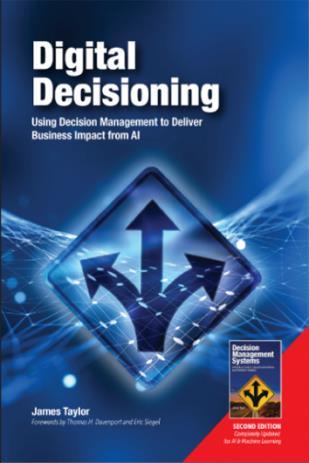
transparency and compliance that established companies and regulated industries demand. By focusing on decision-making, it supports continuous learning and improvement. Described as “Essential reading for COOs looking to rigorously improve automation through AI”, the book is based on dozens of successful projects around the world. It lays out the basic elements of the approach in a practical how-to guide. Aimed at managers, not technical teams, it aims to focus machine learning and artificial intelligence efforts. It emphasizes practical “do this next” advice delivered in non-technical terms, describing the business value and impact of critical technologies without diving into technical detail. Stories of real implementations, real companies, show what can be done.
The book has “a wealth of practical knowledge and advice for beginners and experts alike”. It introduces the opportunity and terminology of AI, explains the business benefits of digital decisioning and outlines the four key principles that underpin successful projects. It introduces a practical three phase approach to delivering digital decisioning based on decision modeling, the right mix of technologies and continuous improvement.

This is a completely updated version of an established and popular book on Decision Management, and has forewords by leading analytic experts, Tom Davenport and Eric Siegel. As one reviewer said:
“I’ve worked as a C-level executive in multiple insurance companies and engaged countless strategy consultants, IT consultants and technology vendors over the past two decades. This book describes the only approach that has actually allowed me to operationalize predictive models and deliver real ROI!”
James Taylor is CEO of Decision Management Solutions and one of the world’s foremost thinker, writer and consultant on using the decision management approach to deliver Digital Decisioning.
Taylor, J. (2019). Digital Decisioning: Using Decision Management to Deliver Business Impact from AI. Florida: Meghan-Kiffer Press.
• ISBN: 9780929652641
• Pages: 202 Digital Decisioning is available from a variety of global booksellers, including: • Barnes & Noble
• Amazon UK
• Booktopia - Australia • Also available in Japanese
SERCTALKS Three-Part Test and Evaluation Series
The Systems Engineering Research Center (SERC) recently completed a three-part series on the future of Test and Evaluation as part of its SERCTALKS research webinars. Moderated by Dr. Laura Freeman, SERC Research Council Member, the series hopes to stimulate an ongoing and more collaborative dialog between academia, government and industry sectors on this important topic. As such, these talks may be valuable resources for anyone seeking to improve their Test and Evaluation practices in a changing technology landscape. The three talks that comprise the Test & Evaluation series are summarized below:
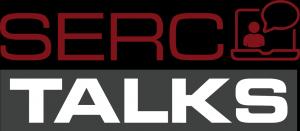
What Does Test & Evaluation Mean in a Digital Engineering Enabled World?
Date: 18 August 2021 Speaker: Dr. Darryl K. Ahner, P.E., Director, Scientific Test and Analysis Techniques Center of Excellence (STAT COE), Air Force Institute of Technology (AFIT) Abstract: Testing has often been looked at as a (un)necessary evil. In order for testing to be value added, it must not take too much time, provide quality information, and provide timely information to appropriate affect systems engineering and acquisition decisions. In this talk we will discuss the demand for testing events, the Scientific Test and Analysis Techniques process (since STAT is mandated in DoD policy anyway), and what test planning may look like in a digital engineering environment. Examples of efficient and effective test planning will also be discussed, both those that were conducted during development and those developed post deployment. Download slides:
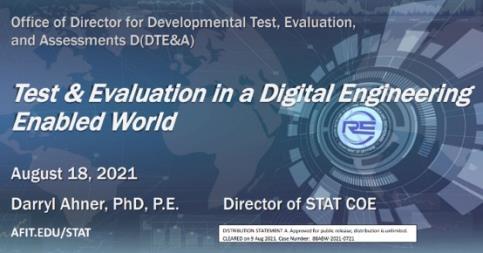
Progress in Test and Evaluation of AI-Enabled Systems in the DoD. Date: 29 October 2021
Speaker: Dr. Yevgeniya “Jane” Pinelis, Chief, Test, Evaluation, and Assessment, Department of Defense Joint Artificial Intelligence Center (JAIC) Abstract: Though the objectives of independent government test and evaluation (T&E) are similar between traditional and AIenabled systems (AIES), the science, practice, skills, and infrastructure necessary to evaluate these data-dependent systems do require an update. Over the last two years, the DoD Joint AI Center (JAIC) has led the DoD test community in identifying and filling the gaps in T&E of AI. We have made great progress, in partnership with other DoD test stakeholders, academia, and industry. Together, we have put forward T&E frameworks, tools, and contracting approaches. This talk will discuss our existing challenges, current and aspirational solutions, and the way ahead for the DoD T&E of AIES. Download slides:

How is T&E Transforming to Adequately Assess DoD Systems in Complex Operating Environments?
Date: 1 December 2021
Speaker: Dr. Sandra Hobson, Deputy Director for Strategic Initiatives, Policy and Emerging Technologies, Office of the Director, Operational Test and Evaluation, Office of the Secretary of Defense Abstract: The Director, Operational Test & Evaluation (DOT&E) is senior advisor to the Secretary of Defense on operational test and evaluation (OT&E) and live fire test and evaluation (LFT&E) in the Department of Defense (DoD). Ultimately, the office of DOT&E is responsible for ensuring testing is adequate to confirm operational effectiveness, suitability, survivability, and lethality of defense systems in combat use. The technologies we are testing today and will in the future require that we rethink classical approaches to T&E. As the National Defense Strategy notes, “We cannot expect success fighting tomorrow’s conflicts with yesterday’s weapons or equipment.” Similarly, we need to modernize T&E assessment tools, infrastructure, and expertise. In this talk, I will discuss the critical role DOT&E plays in ensuring we provide systems that work to our warfighters. I will discuss how the DOT&E Science and Technology Strategic Plan is focusing on making advancements in current T&E CONOPS in the technology areas of Software, Cybersecurity, and NextGeneration capabilities. I will also discuss the need for an integrated T&E lifecycle and how digital transformation plays a key role in changing how we do business. Finally, transformation will require us to engage the T&E workforce in education and training on new methods. New partnerships with communities pioneering new methods (to including the SERC network in academia) will assist in our transformation.
Download slides:
Recordings are available for each of the talks on the SERC YouTube Channel. See previous SERC TALKS series and topics here.
IEEE Standard Model Process for Addressing Ethical Concerns During System Design
The IEEE Standards Association (IEEE SA) released a new standard in September 2021 to provide a clear methodology to analyze the human and social values that are relevant for an ethical system engineering effort. IEEE 7000™-2021 - IEEE Standard Model Process for Addressing Ethical Concerns During System Design, is recommended for use by organizations that seek to apply broader ethical value criteria and minimize risk, thereby helping to strengthen relationships with their end users and customers. Both system/product developers and end users may benefit from this process that considers ethical issues early in the system life cycle, along with system functionality and performance. The intent of the standard is to align products and services with results that honor the contextual values of customers, citizens, and society at large. The standard is particularly applicable to innovation in Artificial Intelligence Systems (AIS) where algorithms invisible to users still may deeply affect the users’ data, identity, and values.
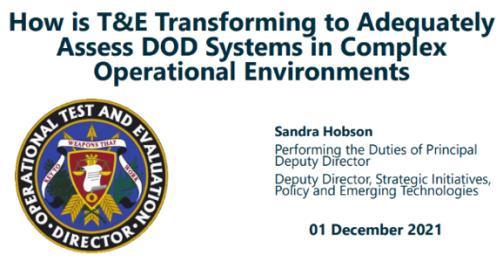

This standard provides: • A system engineering standard approach for integrating human and social values into traditional systems engineering and design. • Processes for engineers to translate stakeholder values and ethical considerations into system requirements and design practices. • A systematic, transparent, and traceable approach to address ethically-oriented regulatory obligations in the design of autonomous intelligent systems. IEEE 7000-2021 is built upon Value-based Engineering (VbE), a methodology providing ways to elicit, conceptualize, prioritize and respect end user values in system design. VbE can reduce project risks by considering potential harm to users and society beyond those harms created by the physical failures associated with a product or service. Click here for more details or to purchase or view the IEEE 7000-2021 Standard. Read the IEEE SA press release.
Definition: Composable design
"Composable design is a systems architecture and development concept focusing on composing new systems from known components, designs, product lines, and reference architectures as opposed to focusing on “blank sheet” designs based on requirements decomposition alone" (Oster and Wade, 2013). Christopher Oster and Jon Wade, "Ecosystem Requirements for Composability and Reuse: An Investigation into Ecosystem Factors That Support Adoption of Composable Practices for Engineering Design’, Systems Engineering, December 2013.
INCOSE UK Systems Engineering zGuides
INCOSE UK has produced a series of guides concerning various aspects of systems engineering. These one-page, double-sided resources (intended to be folded into a three-panel Z-shaped format) are intended to be passed along to individuals who infrequently interact with systems engineering tasks. Generally written in a What – Why – How flow, each topic is addressed in language that can reduce communication barriers among team members.
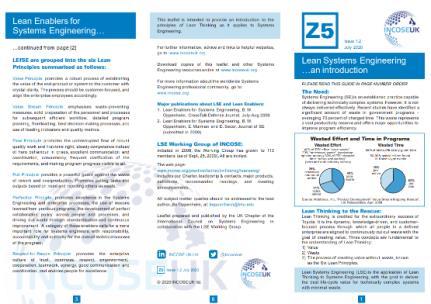
Topics addressed include: • Systems Engineering • What is Systems Engineering? • Enabling Systems Engineering • How Systems Engineering Can Save your Business Money • SSM - Soft Systems Methodology • Lean Systems Engineering • SYSTEMS ENGINEERING RESOURCES • Systems Engineering Competency Framework • What is Systems Thinking?
• System Architecture • Project Management and Systems Engineering • Human Factors for System Engineers • Systems Engineering and Project Management – Top Ten Tips • An Introduction to systems approaches for SMEs Access zGuides here.
PPI RESOURCES
PPI offers a multitude of resources available to all of our clients, associates and friends! Click on any of the links below to access these resources today. Systems Engineering FAQ: https://www.ppi-int.com/resources/systems-engineering-faq Industry-related questions answered by PPI Founder and Managing Director Robert Halligan.
Key downloads: https://www.ppi-int.com/keydownloads/ Free downloadable presentations, short papers, specifications and other helpful downloads related to requirements and the field of Systems Engineering.
Conferences: https://www.ppi-int.com/resources/conferences-and-meetings/ Keep track of systems engineering-relevant conferences and meeting dates throughout the year.
Systems Engineering Goldmine: https://www.ppi-int.com/se-goldmine/ A free resources with over 4GB of downloadable information relevant to the Engineering of systems and a searchable database of 7,800+ defined terms. You can expect the content of the SE Goldmine to continue to increase over time.
Systems Engineering Tools Database (requires SEG account authorization to log
in): https://www.systemsengineeringtools.com/ A resource jointly developed and operated by Project Performance International (PPI) and the International Council on Systems Engineering (INCOSE). The SETDB helps you find appropriate software tools and cloud services that support your systems engineering-related activities. As a PPI SEG account holder, you have ongoing free access to the SETDB.
PPI SyEN Newsjournal (actually a substantial monthly SE publication): https://www.ppiint.com/systems-engineering-newsjournal/ You’re already reading our monthly newsjournal! However click on the link to access the history of 100+ monthly newsjournals containing excellent articles, news and other interesting topics summarizing developments in the field of systems engineering.



